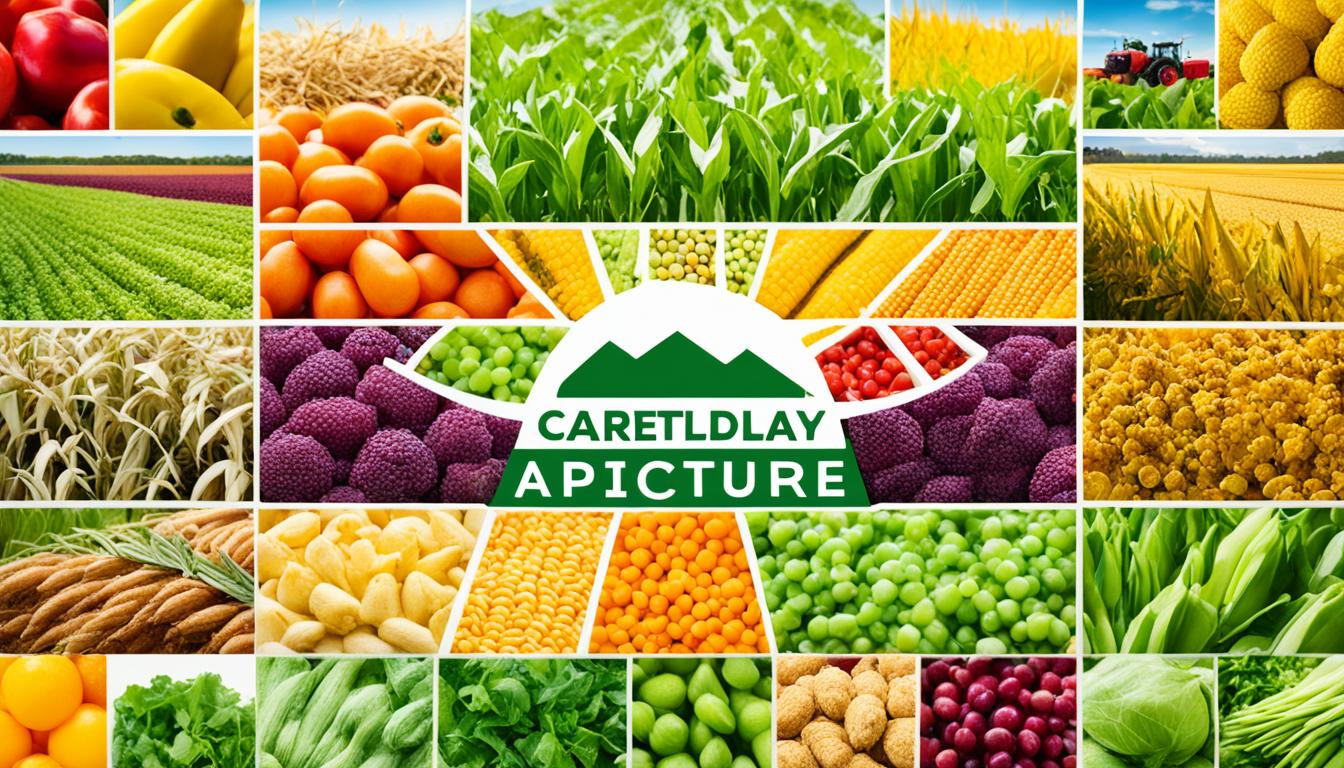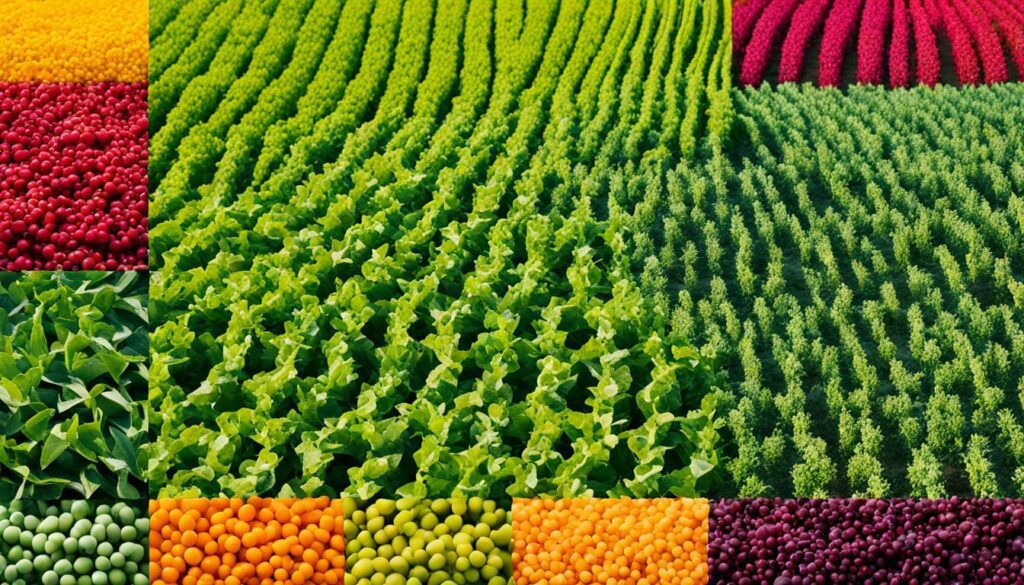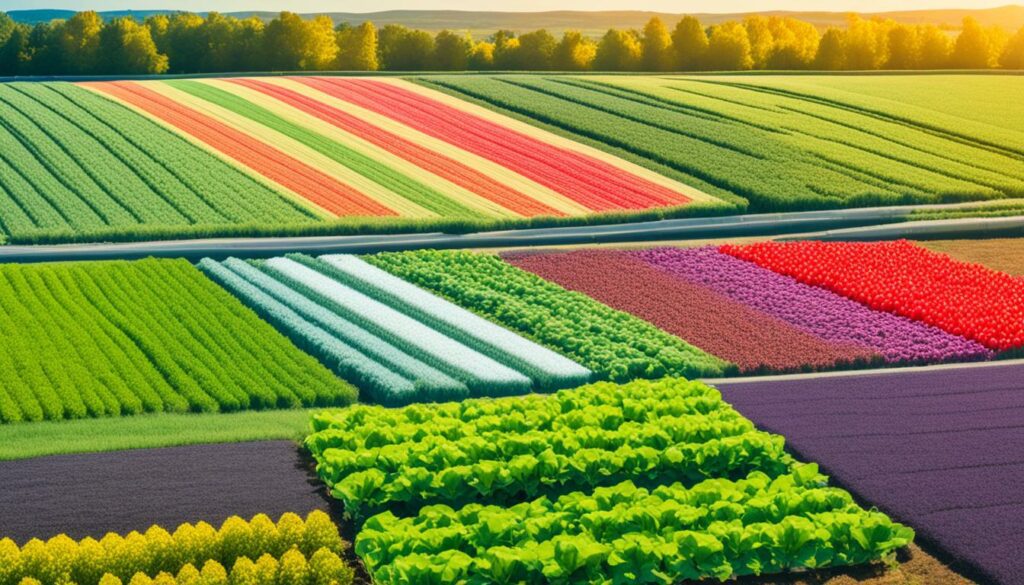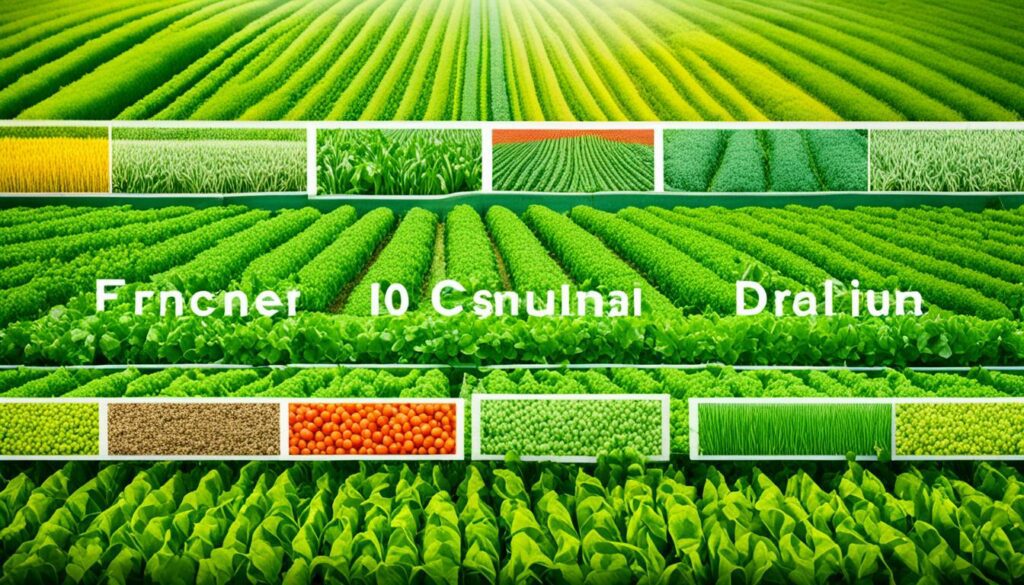Menu

Market segmentation strategies can boost sales by over 20%. This is a key point for agribusinesses. By dividing the market based on needs, preferences, and behaviours, they improve their sales significantly.
Factors like El Niño and government policies highlight the need to understand farmers’ preferences. CIMMYT’s work in Africa is a good example. They focus on creating maize varieties that withstand climate changes, serving farmers better.
CIMMYT and the CGIAR lead workshops on market intelligence for better breeding strategies. These events help create products that meet specific market needs. They involve national programmes, seed companies, and others in the agricultural sector.
Market segmentation in agriculture means finding different groups with unique needs within the market. It helps create strategies that truly meet what consumers want. This way, farmers can focus on what different people need, making their products more successful.
Market segmentation helps farmers figure out what each group of consumers needs. By using careful analysis, they can create products that fit these needs perfectly. This makes their products more successful in the market. Knowing what people like and want helps create better products just for them.
Over time, understanding different market segments has been key. For instance, using data from the 1987 and 1997 Census of Agriculture, along with other surveys, has been very useful. This data helped farming businesses improve how they target consumers. It made their products better suited to what people were looking for.
Now, with modern technology and changing climates, market segmentation has become even more important. Gathering detailed market data and considering many different views is crucial. Big farms that take advantage of economies of scale can price higher and buy cheaper.
Technological advances, like automation, are vital too. They boost productivity, which is key in being competitive. National and international demands encourage constant innovation in farming methods. This shows how important it is to match products to what the market really needs.
| Farm Type | Revenues |
|---|---|
| Sundowner | Under $50,000 and over $35,000 in non-farm income |
| Family Farms | $50,000 – $150,000 annually |
| Commercial Operators | $150,000 – $500,000 with off-farm income of $20,000 – $60,000 |
| Large Scale Operations | $500,000 – $20 million |
Segmentation strategies are vital for agribusinesses looking to shine in complex markets. They use criteria like location, age, interests, and buying habits to adjust what they offer. This includes studying the market deeply to find the best segments.
Segmenting agricultural markets is key for fair resource use and meeting client needs better. It also sharpens the company’s strategy and lets them measure success more clearly. For example, the HarvestChoice program uses location and farming data to make better policies.
A good method is to look at farmers as individuals, which the Farmer Focus project does well. They talk to farmers directly to learn about their unique needs and wants. This detailed approach helps offer solutions that truly fit, making farmers happier.
When it comes to poverty reduction, focusing on different farming areas and their needs can be very effective. For instance, research shows it’s important to look at how crowded an area is, how easy it is to sell goods, what crops can grow there, and its height above sea level. These points help target aid to areas where it can do the most good.
The banking world also finds segmentation helpful. A survey by the World Bank shows that banks split their farming clients into groups based on size and type of business. This helps them offer financial services that meet each group’s specific needs better.
When banks accurately assess their market and match products to clients’ needs, both sides win. For instance, they might look at what each farm does, like growing crops or raising animals. Then they can refine who they’re dealing with by looking at things like how much they earn, borrow, or what they own.
Analysing target markets and applying smart segmentation techniques offer agribusinesses key insights. Understanding and serving the varied needs of agricultural customers can lead to more customer engagement and loyalty.
Crop segmentation is key in linking breeding goals with market needs. It ensures varieties are made for local conditions and what people prefer. This approach meets the demands of different regions.
Climate and region play a big role in crop segmentation. In Africa, different maize types fit certain areas better because of varied climates. It’s also important to know what consumers want, like yellow maize for its health benefits.

In Kenya and Zimbabwe, CIMMYT workshops discussed the needs of farmers, seed industries, and consumers. They aimed to improve breeding strategies for better agriculture outcomes. These talks focused on agricultural market segmentation.
CIMMYT’s maize breeding shows successful crop segmentation. They tailored their work to Africa’s unique markets and needs. This collaboration led to improved maize types through discussions with various experts.
Here’s a comparative insight:
| Factors | Eastern Africa | Southern Africa |
|---|---|---|
| Key Attendees | Kenya, Uganda, Tanzania, Ethiopia | Zimbabwe, Mozambique, Malawi, South Africa, Zambia |
| Main Focus | Refining gender-intentional Target Product Profiles | Balancing farmer, seed industry, and consumer preferences |
| Projected Outcomes | Streamlined market segments | Improved maize varieties aligned with regional needs |
Breeding programmes must match what the market needs. By improving how we target markets, we can better meet farmers’ needs and market demands. This leads to more effective farming solutions that work for different market groups.
In agriculture, it’s vital for businesses to know their market well. This includes demographics, psychographics, and behaviours. These help split the market into groups for better targeting.
Understanding age, income, and where people live is key. Farmer Focus data shows how diverse farmers are. It points to different needs. Matching products to these needs is crucial.
Lifestyle, values, and attitudes are also important. HarvestChoice uses these to understand farmers worldwide. It makes marketing that fits their lives. This helps group consumers sensibly.
How people buy and interact with brands matters a lot. SWOT and Porter’s can help here. They offer insights into consumer trends. This info is key to staying ahead in the market.
Market analysis in farming must look at every angle. By combining demographics, psychographics, and behaviours, we can shape great marketing plans. Understanding what consumers want leads to success.
Understanding how people or businesses choose and use agricultural products is key. This knowledge helps in dividing the market well. By looking into data from various sources, we learn a lot about their choices.
Research in Turkey shows that consumers at farmers’ markets mainly fall into two groups: ‘Conventional Consumers’ and ‘Conscious Consumers’. Over 60% are ‘Conscious Consumers’. They care about quality, freshness, and where products come from.

To plan for the future of farms until 2016, we use scenario planning and simulation. This is crucial to face changes in the market. New farming technologies and economies of scale affect farm sizes and numbers.
In Turkey, motivators at farmers’ markets are variety, talking to farmers, and a welcoming environment. This shows the value of connecting with consumers. It’s vital for agribusinesses to use these insights in their strategies.
| Transition Drivers | Impact on Farm Types |
|---|---|
| Size Economies | Accelerates growth in larger scale operations |
| Technology | Increases efficiency and supports expansion strategies |
| Profitability/Growth Focus | Varies depending on market pricing and farm size |
By using what we know about how people buy agricultural products, businesses can segment their markets better. Knowing what consumers want helps in preparing for the future. It’s about more than meeting current needs; it’s about growing in a tough market.
Market segmentation helps farms use their resources better. It lets them focus on meeting the specific needs of different market parts. Doing this makes their marketing and product work better, which leads to more efficiency.
Market segmentation boosts how well farms work. It means they can make products and market them in specific ways. The HarvestChoice program in East Africa showed that understanding different areas can improve how fertilisers work. These insights help farms focus on what really matters in each region.
Market segmentation also helps farms spend their resources wisely. By choosing the best market areas, they spend money where it matters most. This focused way of working cuts waste and saves money, letting them do more meaningful research. The Ministry of Agriculture, for example, focused on selling better maize seeds where they were most needed. This makes sure farmers get what they need most.
Also, knowing about farmers helps to give resources in a smart way. The Farmer Focus project, for instance, uses details about farmers to spend money better. This makes both money and environmental efforts go further.
Market analysis is key for knowing the agricultural business. It helps us see market trends through numbers and characteristics. An example is the agriculture analytics market, which hit USD 698.8 million in 2019. It’s growing at a rate of 16.1% each year, which is a big opportunity.
It’s important to split the market into groups to better meet customer needs. Things like market share and breakeven analysis are crucial for this. The BCG and GE-McKinsey matrices help by showing where to focus and what’s growing.
The BCG matrix is great for seeing which products are doing well and which need work. It divides products into stars, question marks, cash cows, and dogs. This helps in deciding how to use resources wisely.

Predictive analytics will also boost growth. The Agriculture Analytics Market is expected to jump from USD 3.32 billion in 2024 to USD 4.22 billion by 2032. Companies like IBM, Deere & Company, and SAP SE are big players. They provide tools to better understand markets and improve products and services.
| Region | Market Size (USD) | CAGR (%) |
|---|---|---|
| North America | Largest market size | 16.1% |
| Europe | Second-largest market share | 11.4% |
| Asia-Pacific | Fastest-growing | 18.3% |
Looking at different uses and types, the solution side has the biggest portion. But, the livestock section is likely to grow the most. This shows the need for smart and focused market splitting.
Using these methods will make companies better at understanding agriculture markets. This leads to smarter business choices.
The first step in agricultural marketing segmentation is to identify different customer groups. This is done through individual assessments and looking at where customers are. The process also includes letting customers choose their own groups.
Evaluating each group’s value and viability comes next. For instance, the HarvestChoice program studied agricultural production and assessed fertilizer policies in East Africa. This was to understand the value cost ratio (VCR) of different strategies.
Using detailed data, like the Farmer Focus initiative, helps in understanding farmers’ attitudes. It gives insights that can be acted on. Other important aspects involve where people are located and what kind of access they have to markets. These details are often key in successfully reaching out to farmers.
A core part of market segmentation is identifying what factors are crucial in targeting customers. These can be things like personal traits, where they live, and their potential in agriculture. The Ministry of Agriculture found that by segmenting the seed sector, more farmers started using better maize varieties. This shows that these strategies can really make a difference in farming outcomes.
Looking into each segment’s profitability and sustainability is crucial after grouping customers. Agribusinesses can then tailor their marketing. They might focus broadly or on specific customer needs. Recognising trends, such as the high number of female farmers in East Africa, is also important. This and using specific FO strategies can improve market performance.
To wrap up, good agricultural marketing segmentation aligns products and services with what customers want. It makes distribution and development efforts more focused and effective. This helps businesses and customers alike.
Market segmentation in agriculture faces many difficulties. These include the changing environment and the economy’s ups and downs. Knowing these hurdles is key for farms and agricultural companies to plan better.
The weather greatly impacts how we divide markets in farming. Tornadoes, storms, and other surprises change what we can grow and how much. This might mean that certain crops are in less demand, affecting the economy. HarvestChoice uses maps and weather trends to predict these changes.
By using these tools, farmers can plan for a rainy day (literally!). They can decide what to plant based on the expected weather. This makes their businesses better prepared for surprises in the market.
The economy also plays a big part in market segmentation. Prices, buying power, and costs going up and down all can influence how people buy. The Ministry of Agriculture looks at the seed market as an example.
In planning for tomorrow, they use computer models to guess how many seeds will sell. They also look at different ways things might go. This helps them prepare. They make their seeds good deals for different types of farmers.
Big farms also save money by growing more, not just by using better tech. This shows how important it is to think about the whole farming market together. This way, they can make the right plans and products to sell.
| Segmentation Dimension | Key Metrics | Impact |
|---|---|---|
| Population Density | High vs Low | Influences market access and resource distribution |
| Access to Markets | Proximity | Determines ease of distribution and market integration |
| Agricultural Potential | Soil Fertility, Water Availability | Affects crop suitability and yield potential |
| Altitude | Highlands vs Lowlands | Impacts crop growing conditions and climate adaptability |
Market segmentation is key in agriculture to match products with what consumers want. The CIMMYT maize program and the CGIAR Market Intelligence Initiative are great examples. They’ve used this technique well to get excellent results.

The CIMMYT maize program is a great example of how knowing a market well can boost innovation. It focuses on making maize types that are great for small farmers and the planet, dealing with different climates. This shows how studying what farmers need and the market conditions helps create products that are just right.
A study looked at farmers markets and found important information. 508 surveys were done, with 379 usable answers. Most who answered were well-educated, middle-aged professionals, mostly white women. This data was crucial in helping the CIMMYT maize program target its efforts effectively.
It found out that around half the families had 2-3 people, and a quarter had 4-5. A small part had more than 5. In terms of money, over 27% made more than $100,000 but 10% made less than $20,000. These details guided the program in understanding different customer groups better, which helped them meet their needs more precisely.
The CGIAR Market Intelligence Initiative shows how important it is to understand a market and work together. It organises workshops for those in the business, like seed companies and farmers. This helps make sure breeding programs meet what different segments of the market need.
To really understand the market, the project looked at many data analysis approaches. It found seven types of full-time farmers and six types of part-time farmers, all with different needs and ways of thinking. Developing these typical customer profiles made it easier to understand what customers do and like. This made the whole process clearer and more useful.
The project’s success is thanks to its focus on usable insights and clear definitions of different market groups. This not only made marketing better but also led to product changes that dairy farmers really liked at big shows. By focusing on distributing resources fairly and targeting educational efforts, the program beat out its competition, even bigger brands.
| Aspect | Data |
|---|---|
| Questionnaires Completed | 508 (379 useful) |
| Gender Distribution | 76.7% Female, 23.3% Male |
| Educational Level | 43.7% Post-Graduate |
| Household Size | 54.0% (2-3 members), 25.1% (4-5 members), 2.7% (Over 5 members) |
| Income Distribution | 27.2% Over $100,000, 10.7% Under $20,000 |
Advanced technological tools are changing how we understand and meet consumer needs in agriculture. They collect a lot of data and help us look at it in detail. This lets us make sense of the information accurately.
Good data collection methods are key to market segmentation. The Market Segmentation Tool (MST) uses more than 100 factors to analyse things. It lets you group farms by several key points like wealth, land and animals they own, and how they sell their products. Data comes from three World Bank surveys, shown on maps and in charts making it easy to see what’s going on.
This tool also shows how easy it is to get to markets, the number of roads, people living in the area, and more. Collecting this detailed data helps companies match their products with what people want.
Having analytical tools in agriculture is very important. The MST makes data interactive, helping people understand it better. These tools help decide which market areas are best to focus on. They can make developing products and marketing them more efficient. And they’re flexible, helping in new places and with more information too.
Using technological tools for market segmentation with advanced data collection and analytics highlights technology’s role in farming today. They turn information into smart strategies, helping companies work better. So, they use their resources well and create products that meet the market’s needs.
| Tool | Main Features | Benefits |
|---|---|---|
| Market Segmentation Tool (MST) | 100+ analysis variables, multi-level maps | Enhanced market intelligence, precise household categorisation |
| Meltwater | Comprehensive consumer intelligence | Effective customer understanding |
| Meta (Facebook) | Improved social media targeting | Better advertising efficiency |
| Pendo | Usage and adoption-based segmentation | Ongoing customer value delivery |
| Twilio Segment | Real-time customer data updates | Optimised personalised marketing |
| Cognism | Advanced lead filtering options | More qualified leads |
| Mailshake | Email cadence action segmentation | Personalised messaging |
Implementing segmentation strategies in agricultural marketing is vital. It helps create focused and efficient marketing efforts. This leads to better products, prices, and promotions by pinpointing the target market accurately.
The research in “Expert Insights on Market Segmentation in Agriculture” digs into the shifts in agricultural markets in the U.S. and worldwide. It looks at how changes influence who buys, and how to market to them. The study uses data from censuses in 1987 and 1997, examining sales, buying habits, and farm sizes.

Knowing how tech and policies affect different farms is important. For example, big farms can use tech to save labour and grow faster. This is known as size economics.
For using segmentation strategies well, the farming sector should keep up with new tech. Things like auto steer and remote sensing improve work and help pick the right machinery or buildings. Combining tech with knowing the market well is key.
Also, it’s crucial to spend resources wisely. Focusing on specific market areas helps use resources better. The World Bank’s success by aiming at specific places and people shows this works better than casting a wide net. It’s about making sure what you offer is wanted by those you aim to serve.
A table summarising key elements for segmentation could include:
| Element | Description | Impact |
|---|---|---|
| Technology | Automation, remote sensing | Improves efficiency, enables expansion |
| Market Knowledge | Historical data, customer bases | Informs segmentation strategies |
| Resource Allocation | Targeted interventions | More equitable and efficient distribution |
| Scenario Planning | Addressing uncertainties | Better future trend projection |
Overall, using segmentation in agricultural marketing means carefully mixing technology, study of the market, and wise use of resources. This way, different market segments can be effectively reached and served.
The future of splitting the agricultural market is set to change a lot. This change comes from new tech and using more data stats. Adding AI, ML, and analytics together helps us look at markets better. It gives firms more info on what farmers might need next.
We know this from looking back at data from 1987 to 2003. A study by Purdue University really helps. It looks at future farms depending on who they sell to. It also looks at how new tech and joining with others might change things.
“Larger farms will soon sell for more and buy for less because they can use new tech better. This will make farming more efficient and help it grow.”
Big farms are becoming more powerful. They do this by using size advantages and new tech. Things like auto-steering and better maps make big fields work as one. The changes are clear in Image 2 of a recent review. It shows how tech is shaping all sorts of farms.
“Larger farms will soon sell for more and buy for less because they can use new tech better. This will make farming more efficient and help it grow.”
Looking ahead, we have the Farmer of the Future 2.0 by Aimpoint Research. This tool groups farmers by how they think and what they like. It’s got a big report and a site you can look at. This helps people see how farmers think and what they might do next.
Trends show we’re moving to smarter ways to see the market. Companies that use new methods and tech are ahead in meeting what the market needs. This helps them stay competitive and grow in farming’s always-changing world.
| Transition Driver | Impact on Farms |
|---|---|
| Size Economies | Higher selling prices, lower purchasing prices |
| Technology | Increased labour efficiency, replication strategies |
| Off-Farm Opportunities | Diversification, income stabilization |
| Vertical Alliances | Improved market access, collaboration |
| Government Payments | Support for sustainability, risk management |
Market segmentation in agriculture is vital for understanding different types of demand. Organisations like CIMMYT hold workshops aided by projects like the CGIAR Market Intelligence Initiative. These sessions teach important things, such as how to include gender views and how working together is key.

These meetings use big sets of data, collected from sources like the 1987 and 1997 Census of Agriculture and 2001 USDA ARMS data. They also look at the overall sector to figure out farm numbers and sizes, a method used in 2016. Workshop findings show how certain changes, like new technology, affect different parts of the market.
Getting farmers involved and sharing their thoughts is crucial in meeting market needs accurately. The workshops also stress that we must plan for the future, because we can’t always rely on past info. Factors such as government support and job opportunities outside farming are also looked at, helping understand how they affect farm sizes and types.
| Segment Type | Classification Data Sources | Stated Impact |
|---|---|---|
| Small-Scale Operations | 1987, 1997 Census of Agriculture | Highly influenced by government payments and risk factors |
| Medium-Scale Operations | 2001 USDA ARMS data | Affected by technology and profitability/growth focus |
| Large-Scale Operations | Purdue University, 2003 survey | Driven by size economies and capital/land access |
Ultimately, the lessons from initiatives like the CGIAR Market Intelligence Programme are key. They shed light on changing factors and new tech, which help with big farms’ labour issues. They also teach us how important it is to work together and use good market research to keep improving agricultural methods.
Government policies have a big impact on how agricultural markets are divided. Changes in rules and government help can change how farmers sell their products. This affects what they create and how they sell it. As the rules change, farms have to change too, to follow the new rules and stay competitive.
Rules can change the market a lot. In 2019, the U.S. saw less farm sales than buys for the first time in 60 years. This made everyone look closer at President Biden’s trading decisions. These big changes mean farms need good plans on how to sell their stuff. Also, in the U.S., it’s now easier or harder to sell new crops that are changed by science. When Germany decided to stop helping farmers buy fuel, many farmers got upset. This shows how rule changes can really shake things up.
Rules can also support new and better farming practices. Places like Asia and Sub-Saharan Africa are working to grow crops that last longer and fight off diseases. This shows that when governments help, farms can do better. In Egypt, food help goes to those who need it most. Tunisia changed how it helps buy food, making sure it reaches those it should. These cases show how government help makes markets work better for everyone.
To stay ahead, farms need to understand and use government rules and help. By working with these, they can sell better and meet what the market wants. This way, farms can last long and do well in their markets.
Market segmentation in agriculture splits the market into different consumer groups. Each group shares similar needs and desires. This helps agribusinesses focus their products and services on what each group values most.
It’s important in agriculture to meet various consumer needs. It helps in making specialised products. Also, it ensures resources are used wisely, which is vital for staying ahead in a diverse and changing market.
Currently, market segmentation uses advanced market research and involves many viewpoints. It updates traditional breeding methods to better match with market needs.
Agribusinesses first look at different market types like where customers are from. They then line up their products to match these groups by seeing which ones are most interested. After, they make plans to reach out to their chosen customers in special ways.
Climate needs, how much crops can produce, and if they fit the area all decide on crop types. For instance, CIMMYT in Africa designs maize that suits various regions, using this strategy.
Looking into who might buy, where they are, and what they like is the start. Then, it checks how they spend money and which brands they prefer. This detailed study helps shape marketing and what products are offered.
It’s all about how people or companies choose to buy and use agricultural products. These choices are shaped by culture, economy, and personal wants.
Segmenting the market helps farms work better, spend wisely, and gain more from investments. It’s about finding the best path to target customers. This can cut costs and lead to more sales.
Both numbers and feelings are looked at in agriculture, like who sells the most and who breaks even. Tools like the BCG and GE-McKinsey matrices help spot market trends and see new chances.
First, finding groups of possible buyers is key. Then each group’s worth is checked out. Finally, the best groups to aim for are picked. This is done through many different marketing plans to match what’s wanted.
Weather surprises and money changes can shake up farming markets. This is a big challenge for deciding what to grow and sell.
Yes, key projects focus on making the right crops for certain areas. CIMMYT in Africa works on maize that grows well everywhere. CGIAR uses info to link up breeding with what the market needs.
New data tools, like smart analytics, dive deep into what people want. This means companies can smartly design products and use their resources better.
To put segmentation in action, market studies and the four Ps of marketing are combined. This brings products closer to buyer needs and better plans for selling them.
More and more, we will rely on data and new tech to make decisions. AI and predictive tools will get better at understanding the market. This should help in meeting upcoming needs.
Learning about what gender wants and how everyone can work together is vital. Also, getting feedback directly from farmers and buyers is a must. It guides making products that people actually need.
Government rules and support change how the market works. Things like new laws or help for farmers can move the market around. This changes how businesses target and sell their products, aiming for more sustainable and innovative practices.